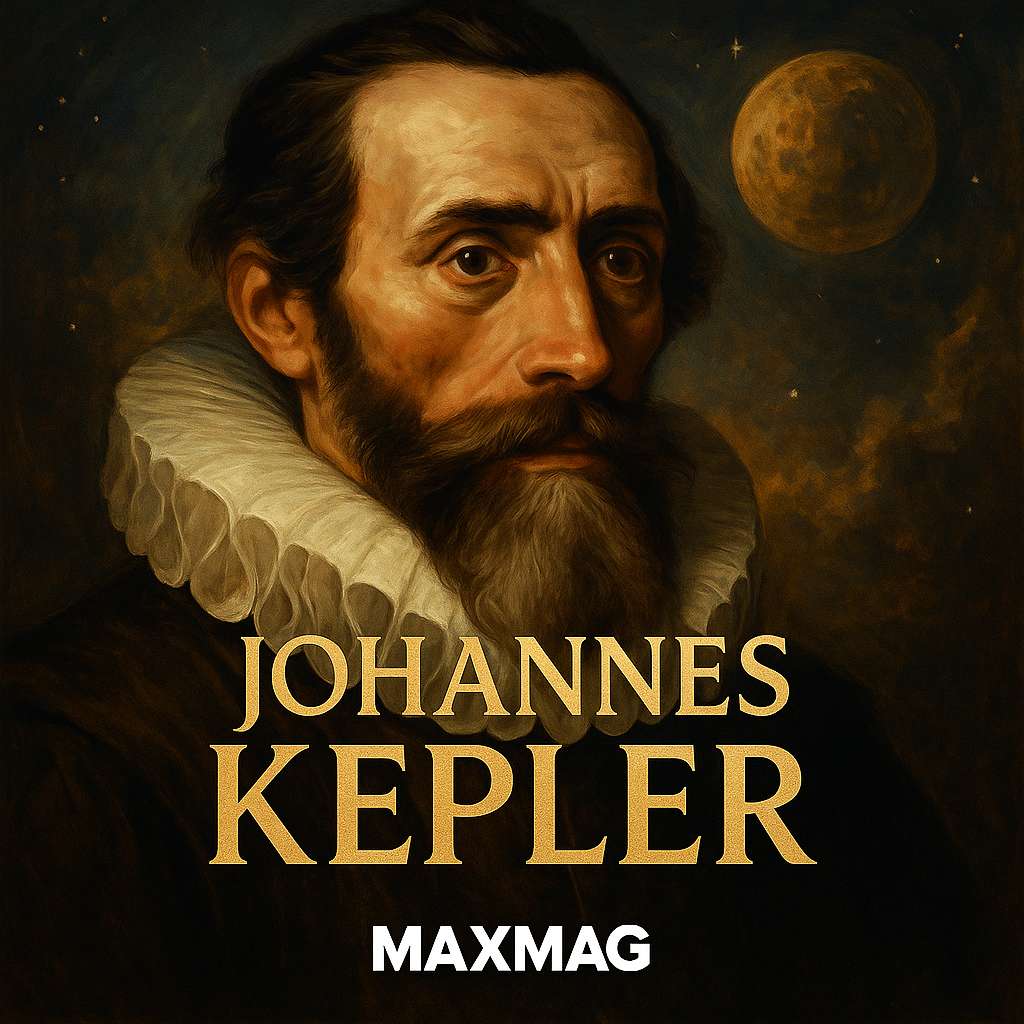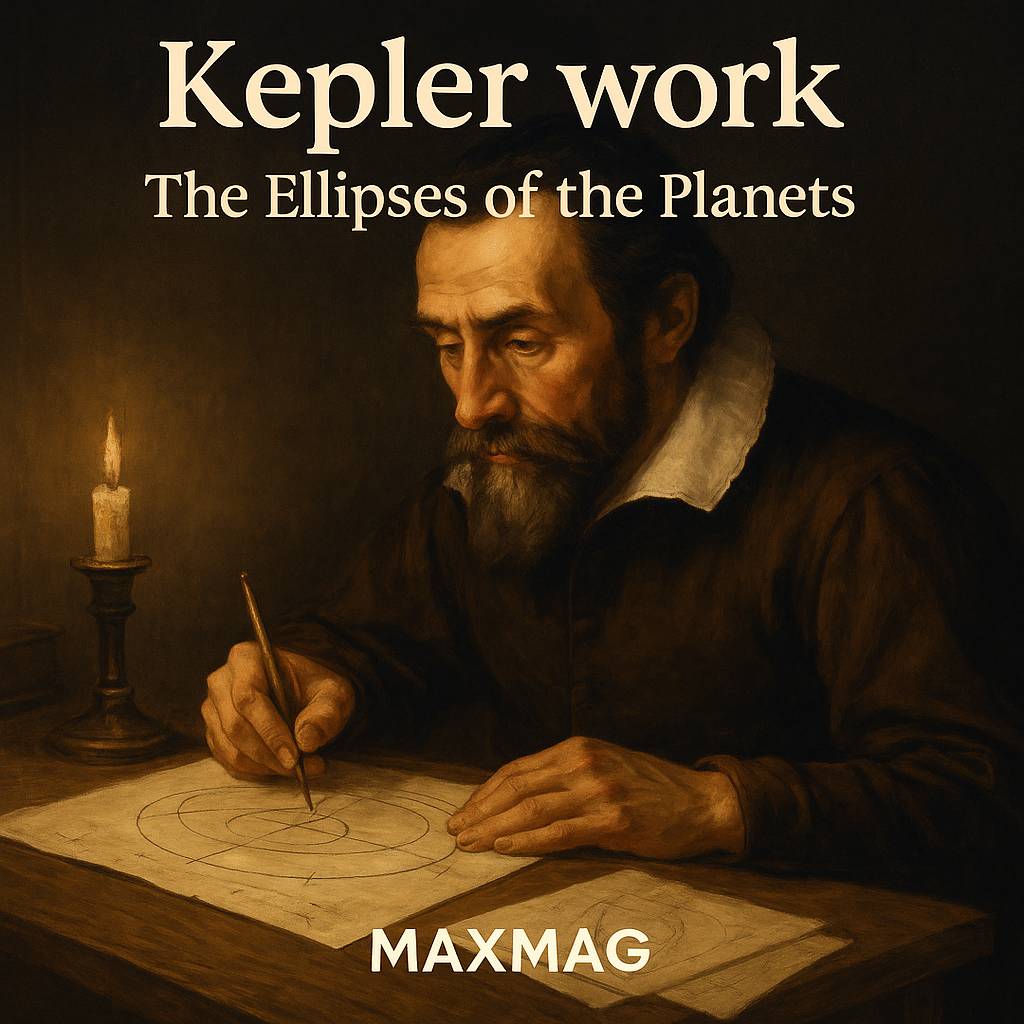
On a winter evening in Prague in the first decade of the seventeenth century, a thin, half-sighted man bends over a desk lit by tallow candles. Outside, carts rattle over frozen cobblestones and the city lives under the shadow of plague and religious fracture. Inside, Johannes Kepler is arguing with Mars. Not with the red dot itself, but with its numbers: angles and distances copied from Tycho Brahe’s notebooks. The planet refuses to behave, and the discrepancy is small—about eight minutes of arc—but to Kepler it might as well be a canyon. “If I had believed that we could ignore these eight minutes,” he writes later, “I would have patched up my hypothesis accordingly. But since it was not permissible to ignore, those eight minutes pointed the road to a complete reformation in astronomy.”
This Johannes Kepler biography begins there, with a stubborn mismatch. Kepler is often introduced as the man who discovered three laws of planetary motion. That is true, but it is the cleanest edge of a jagged life. He was a refugee of conscience in the middle of Europe’s confessional wars, a court employee who distrusted courts, a practicing astrologer who mocked superstition, and a religious mystic who demanded proof. He lived in a world where universities taught Aristotle, churches fought over doctrine, and the heavens were assumed to move in perfect circles. Into that world he brought a different ethic: let measurement correct your dreams, and let the sky be stranger than your philosophy.
At a glance: Johannes Kepler (1571–1630) was a German astronomer and mathematician of the Scientific Revolution. Using Brahe’s unmatched observations, he showed that planets travel around the Sun in ellipses, change speed according to an “equal areas” rule, and obey a harmonic relationship between their distance and year length. His laws became the launchpad for Newtonian gravity and remain basic to spaceflight today.
Early Life and Education of Johannes Kepler
A childhood under bad stars—and sharper questions
Kepler was born in 1571 in Weil der Stadt, a small imperial town on the edge of the Black Forest. His start in life was physically fragile. He was premature and sickly, and as a child he contracted smallpox, leaving his hands scarred and his eyesight permanently weak. His father, Heinrich, earned money as a mercenary soldier and drifted away from the household before vanishing for good, presumed killed abroad. His mother, Katharina, ran a tavern, practiced folk medicine, and carried a reputation in town for being hard-headed and sharp-tongued. Kepler inherited both her tenacity and, later, her misfortune.
Two celestial events carved themselves into Kepler’s memory. At five he watched the Great Comet of 1577 with his mother; at nine he was woken to see a total lunar eclipse. Neighbors talked of omens, but Kepler stored the details—the color of the shadow, the slow geometry of motion—as if the sky had offered him a first puzzle. Those moments taught him a lifelong habit: to treat wonder as evidence waiting to be understood.
The Tübingen years: theology, mathematics, and Copernicus at the back of the room
Kepler’s talent won him scholarships through Lutheran schools and, at last, to the University of Tübingen. The official goal was to train Protestant clergy, and Kepler took his theological studies seriously. Yet he also fell under the influence of Michael Maestlin, the university’s mathematics professor and a quiet Copernican. Maestlin taught heliocentrism as a useful computational device. Kepler adopted it as physical truth. He argued for a moving Earth in student debates, not as provocation but as a moral obligation to the best explanation available.
The decision to become a Copernican was also a decision to live as a dissenter. In retrospect, the seed of every later breakthrough in this Johannes Kepler biography is visible in those lecture halls: an allegiance to evidence even when it scrapes against comfort.
Johannes Kepler biography and the Birth of Their Big Ideas
Johannes Kepler biography and the dream of a geometric universe
In 1594 Kepler was sent to Graz as teacher of mathematics and district astronomer. Barely in his twenties, he published his first book, Mysterium Cosmographicum (1596). The work is equal parts geometry lesson and devotional confession. Kepler proposed a breathtaking “cosmic blueprint”: the spacing of the six known planets could be explained by nesting the five Platonic solids—cube, tetrahedron, octahedron, dodecahedron, icosahedron—between their orbits. The universe, he suggested, was built from perfect shapes, like an architectural model visible through the thin veil of the night sky.
The model was wrong, but its impulse was revolutionary. Kepler would not settle for a scheme that merely reproduced planetary paths. He wanted a cause, a reason, a physical architecture. Even when the Platonic solids fell away under better observations, the demand for underlying explanation remained his north star.
Astrology as day job and laboratory
Graz also forced Kepler into astrology. City officials expected horoscopes and annual almanacs; the fees kept him afloat. He believed celestial configurations might correlate with weather or temperament, but he scorned crude fortune telling. What mattered for his later work was the technique. Astrology demanded exact planetary positions, so Kepler learned to compute with a precision most theorists avoided. When he later spoke of the Sun “driving” the planets with something like a force, he was adapting an astrologer’s habit of looking for regular influence into a physicist’s search for mechanism.
Section wrap-up: By the end of his twenties Kepler had not found the right model, but he had found the right attitude: the universe had a real structure, and real structure could be proved.

Key Works and Major Contributions of Johannes Kepler
Tycho Brahe’s data: a fortress and a key
Religious conflict soon upended Kepler’s life. As a Lutheran in a Catholic-ruled province, he was expelled from Graz in 1600. He traveled to Prague after receiving an invitation from Tycho Brahe, Europe’s premier observational astronomer. Tycho had built instruments of unprecedented precision and compiled planetary measurements accurate to within minutes of arc. He was also aristocratic, prickly, and possessive. Kepler arrived desperate to test his visions. Tycho handed out the precious data like rations.
The collaboration was tense but fateful. Tycho needed Kepler’s mathematical imagination to turn raw observation into theory. Kepler needed Tycho’s data to keep imagination honest. When Tycho died suddenly in 1601, Kepler inherited the observational trove and the post of Imperial Mathematician to Emperor Rudolf II.
The first law: the ellipse breaks the spell of the circle
Kepler’s main assignment was Mars. He began traditionally, assuming a circular orbit and refining it with every mathematical trick he knew. The numbers refused to align. After years of grinding work he faced one stubborn remainder: about eight minutes of arc between Tycho’s observations and his best circular model. These eight minutes were not a rounding error; they were a verdict. Kepler made the scandalous leap that became his first law: planets move in ellipses, with the Sun at one focus.
To modern eyes the ellipse seems an obvious possibility. In Kepler’s day it was intellectual heresy. Circles were tied to ideas of divine perfection and cosmic hierarchy. By abandoning them, Kepler traded aesthetic certainty for fidelity to nature.
The second law: speed as a clue to force
Mapping the ellipse revealed another fact. Mars, and therefore other planets, did not move at constant speed. A line joining planet and Sun sweeps out equal areas in equal times; close to the Sun the planet races, far away it drifts. If the statement feels abstract, imagine a skater spinning with arms extended: pull them in and she spins faster. Distance changes speed. Kepler did not yet possess Newton’s mechanics, but he sensed that variable speed implied a physical cause. He spoke of a “virtue” flowing from the Sun like light, pushing the planets along their paths.
The third law: the harmony hiding in plain sight
In 1619, in Harmonices Mundi (Harmony of the World), Kepler found a final relationship tying all planets together. The square of a planet’s orbital period is proportional to the cube of its average distance from the Sun. It was the simplest rule he had ever written and the one he most loved, because it sounded like music: a single scale for the solar system. This law turned scattered orbits into one coherent family.
Optics and the Keplerian telescope
Kepler’s mind ranged beyond orbits. In Astronomiae Pars Optica (1604) he explained vision as an image formed on the retina and treated light as something that travels and bends. In Dioptrice (1611) he analyzed refraction and lens combinations, describing a telescope using two convex lenses. The design offered a wider field of view than Galileo’s and became the standard refracting telescope for later astronomers.
Section wrap-up: Kepler’s laws and optics turned heliocentrism from a proposal into a predictive, physical astronomy.

Methods, Collaborations and Working Style
The grind behind the elegance
Kepler worked with one foot in visionary speculation and the other in bookkeeping. He started with bold hunches—sometimes mystical, sometimes mechanical—then smashed them against observation. Without calculus, and with logarithms only late in career, he computed by hand with almost monastic endurance. Any modern student who has cursed through a long spreadsheet would recognize the grind in his notebooks.
Science by mail: allies, rivals, and Galileo
He also belonged to the “Republic of Letters,” the international network of scholars who argued by correspondence. Kepler exchanged ideas with Galileo and defended the telescopic discoveries that strengthened heliocentrism, even when he disagreed with Galileo’s sometimes combative style. At the same time he sparred with traditionalists who defended circles on metaphysical grounds. The scientific revolution was not a clean march from error to truth; it was a loud public argument about what counted as proof.
Controversies, Criticism and Misconceptions
Mystic or scientist? The productive tension
It is tempting to cast Kepler as a modern scientist trapped in a superstitious era, or to dismiss him as a mystic who happened to stumble into correct equations. Both views miss the point. Kepler’s belief in cosmic harmony guided his search for patterns; his reverence for Tycho’s observations forced him to abandon any pattern that failed. The ellipse was born from that friction.
The witchcraft trial of Katharina Kepler
Kepler’s reputation for reason did not protect his family from the age’s fears. In 1615 his mother Katharina was arrested for witchcraft in Württemberg. Such charges often ended at the stake. Kepler traveled home, studied court procedures, and wrote a meticulous defense that picked apart the accusations. After fourteen months imprisoned and threatened with torture, Katharina was released. The case dragged on for years, draining Kepler emotionally and financially.
For someone devoted to laws of nature, the spectacle of an evidence-free trial was a personal nightmare. It hardened his distrust of authority detached from reason.
Impact on Astronomy and on Wider Society
Johannes Kepler biography and the road to Newton
Kepler’s three laws quickly became indispensable to astronomers, even among those uneasy with their philosophical implications. In the 1680s Isaac Newton demonstrated that an inverse-square gravitational attraction naturally produces Kepler’s ellipses and area rule. Kepler supplied the patterns; Newton supplied the underlying engine. In this way, Kepler belongs to the deep prehistory of physics as much as to astronomy.
From orbits to spacecraft
The reach of Kepler’s work extends to every satellite and interplanetary probe. Orbital mechanics still begins with his laws, whether you are plotting a communications satellite above Earth or a transfer orbit to Mars. NASA’s own summary gives a clear modern statement of how these rules guide spaceflight. NASA’s overview of Kepler’s laws.
Kepler’s supernova and a changing heaven
In 1604 a brilliant “new star” appeared in Ophiuchus. Kepler observed it nightly and published De Stella Nova (1606), insisting that the heavens could change. We now know the event as Kepler’s Supernova, a Type Ia explosion and the last supernova in the Milky Way visible to the naked eye. By treating it seriously, Kepler helped dismantle the old Aristotelian idea of an immutable celestial realm.
Section wrap-up: Kepler’s impact was double: he wrote laws for planetary motion and helped redefine what a scientific explanation is.

Personal Beliefs, Character and Private Life
Faith, exile, and the costs of conscience
Kepler never stopped thinking as a theologian. He described science as reading the “book of nature” alongside scripture. Yet he also refused to let doctrine bully observation. That stance carried a price. He was expelled from Graz for refusing to convert to Catholicism and later faced similar pressures elsewhere. His life became a chain of temporary homes, each one dependent on patronage and fragile tolerance.
Family life in the shadow of plague
Kepler married twice and fathered thirteen children, but only a few survived to adulthood. His first wife, Barbara, died after long illness; several children died young, likely from the period’s relentless epidemics. He wrote tenderly about his surviving son Ludwig and with stunned sorrow about the dead. Household records show him borrowing money, pleading for salary, and carrying manuscripts between cities while caring for a family buffeted by disease.
Later Years and Final Chapter of Johannes Kepler
The Rudolphine Tables: a practical masterpiece
Amid war and displacement, Kepler produced one more monumental work: the Rudolphine Tables (1627). Based on Tycho’s data and corrected by Kepler’s ellipses, they predicted planetary positions with unprecedented accuracy. Navigators used them at sea; astronomers used them to test new ideas. They were proof that a mathematically honest universe is also a useful one.
Death on the road
In 1630 Kepler traveled to Regensburg to collect unpaid salary. He arrived sick—perhaps with fever or pneumonia—and died there at 58. His grave was later destroyed during war. The man who mapped permanence into the skies left no permanent marker on Earth.
The Lasting Legacy of Johannes Kepler biography
Johannes Kepler biography and the modern meaning of evidence
Kepler’s deepest legacy lies not only in the ellipses but in the way he found them. He treated small disagreements between theory and observation as precious clues. If the data were good, the theory had to bend. That intellectual humility is now the default posture of science, but it was not default in 1600.
A human revolution worth re-reading
A Scientific American reflection on Kepler’s 1609 breakthrough captures how startling his rejection of circles was to contemporaries, and how it rivaled Galileo’s achievements in the same year. Scientific American on Kepler’s revolutionary achievements.
Viewed from a distance, Kepler can look like a set of formulas bracketed by dates. Viewed up close, he is a human drama: a man negotiating between faith and fact, between social chaos and cosmic order, between the hunger to find meaning and the discipline to accept surprise. His story shows why the scientific revolution was not a clean overthrow but a painful re-education of imagination.
This Johannes Kepler biography ends with that lesson. In a world still tempted by elegant stories that ignore stubborn reality, Kepler’s life reminds us to trust the mismatch—the eight minutes of arc that say, “look again.” Understanding the Johannes Kepler biography helps us see something bigger: science advances when someone refuses to explain away a small, nagging fact.
Frequently Asked Questions about Johannes Kepler biography
Q1: What are Johannes Kepler’s three laws of planetary motion?
Q2: How did Kepler use Tycho Brahe’s observations?
Q3: Why were Kepler’s ellipses such a big deal?
Q4: Did Kepler really believe in astrology?
Q5: What happened in the witch trial involving his mother?
Q6: Beyond the three laws, what else did Kepler contribute?




